UVC LEDs are supplanting lamp-based systems for high-performance liquid chromatography, water-quality assessment and process monitoring in the food and beverage industry.
HARI VENUGOPALAN, CRYSTAL IS INC.
UVC LEDs are fast becoming the technology of choice for designers developing a new breed of spectroscopy devices that are smaller, less costly and more energy-efficient, while still delivering precise, real-time measurements. With efficiency and performance levels that rival traditional lamp-based systems, UVC LEDs are an integral component in new instruments for a range of applications, including high-performance liquid chromatography (HPLC), water-quality monitoring and process monitoring in the food and beverage industry.
Granted, LEDs are an established technology, offering a small footprint, ease of alignment and enhanced end-user productivity. But adoption of earlier sapphire substrate UVC LEDs in the 250- to 280-nm range was relatively limited due to performance and reliability issues.
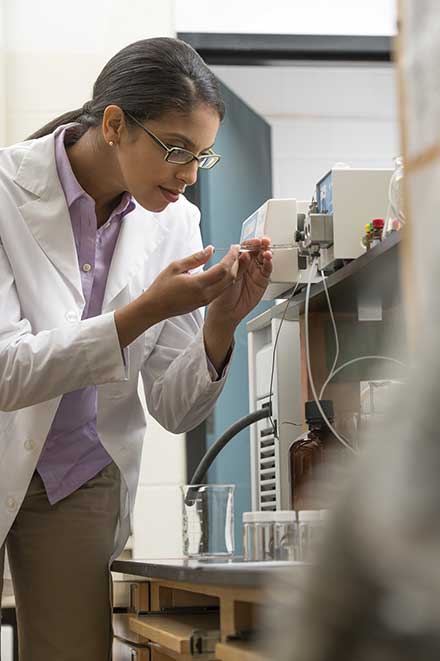
UV fluorometry is used to monitor oil and hydrocarbons in water because the aromatic component in these substances fluoresce under UV light. UVC LEDs offer narrow wavelenghts for selective, targeted measurements; allow for a small footprint for easy inline monitoring of water quality; and offer high light output for trace detection at the parts-per-billion level. Courtesy of Crystal IS Inc.
To improve performance, new lattice-matched single-crystal aluminum nitride (AlN) substrates were developed. With approximately 10,000 fewer defects per square centimeter, LEDs based on native AIN substrates provide enhanced light generation and a substantially longer service life.
As a result, UVC LEDs are now used in a growing number of spectrometers, especially in life sciences applications where fast, accurate and dependable measurements are required. This is especially true in applications that rely on quantitative analysis through absorption spectroscopy, such as HPLC and DNA concentration and purity measurements.
Leveraging lattice-matched UVC LEDs, Lenexa, Kan.-based Marion Research LLC
recently developed a portable HPLC detector that exceeds the performance of traditional fixed wavelength detectors, but
at less than half the cost, and less than one-tenth the size, weight and power consumption. The new LEDs helped Marion Research designers overcome a number of technical hurdles. Traditional HPLC systems use deuterium (D2) lamps, which deliver a very stable light output. However, new LED designs are more stable than high-end deuterium lamps (Figure 1). With UVC LEDs, light fluctuations are 0.002 percent, while deuterium lamps range from 0.005 to 0.05 percent. UVC LEDs also provide higher light intensity at specific wavelengths, which makes the instrument’s measurements more sensitive.
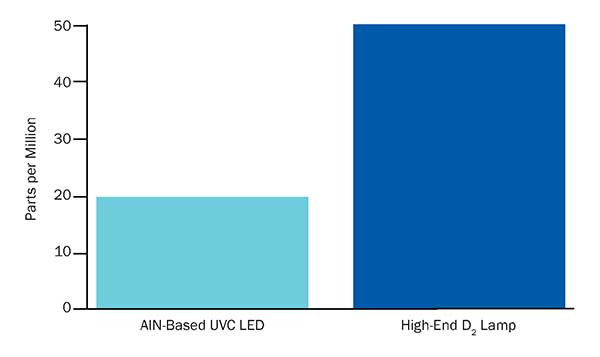
Figure 1. Comparison of light output fluctuation (stability) between an AlN (aluminum nitride)-based UVC LED and a high-end deuterium (D2) lamp. Peak-to-peak fluctuation within each 30-second interval is measured and averaged over a 15-minute time frame. Courtesy of Crystal IS Inc.
In addition, many common chromatography applications require only one or two fixed wavelengths. Traditional, deuterium lamp-based HPLC systems offer a wide range of wavelengths — usually more wavelengths than are needed. UVC LEDs, which emit light in a narrow wavelength range rather than the broad spectrum of a deuterium lamp, allowed Marion Research to develop new, smaller devices that target specific applications.
The system is designed for wavelength applications in the 250- to 280-nm range. Employing UVC LEDs helped the company simplify the design of the optical train and use fewer, less costly components. The power supply and photodiode is less expensive when compared to a traditional deuterium lamp-based system, which requires a costly power supply, a
monochromator to filter out other wavelengths, and a photodiode array for detection.
Because of the near-monochromaticity of the LEDs, Marion Research designers selected the wavelength to match the absorption spectrum of the compound of interest. Compared to the broader spectrum of deuterium lamps, the LEDs offered more irradiance at a specific wavelength in the deep UV range (Figure 2) and the detector successfully delivered the high level of sensitivity required for the application.
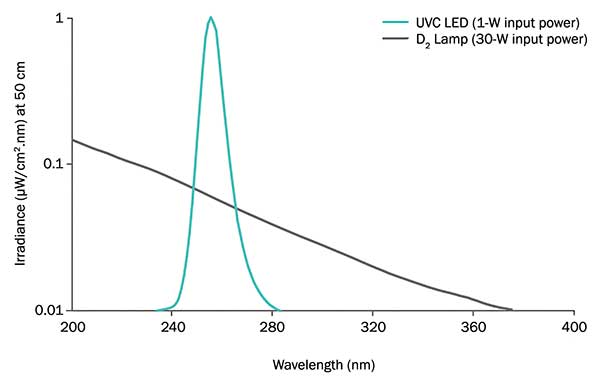
Figure 2. Irradiance comparison of a UVC LED with a peak at 255 nm versus a typical deuterium lamp. Courtesy of Crystal IS Inc.
The UVC LEDs also allowed the company to simplify the instrument’s optical design with fewer components, and less bulky power supplies. The result is an extremely compact (44-mm diameter × 44-mm long), low-cost detector, one that can be used in the lab, or the field for environmental or point-of-care diagnostics.
Monitoring pollution
UVC LEDs are also helping the shipping industry monitor and substantially reduce its emissions footprint.
Shipping companies have been burning high-sulfur bunker fuel for decades, releasing nitrogen oxides (NOx), sulfur oxides (SOx), polycyclic aromatic hydro-carbons (PAHs) and particulates into the atmosphere. By one estimate, the 15 largest ships in the world create more pollution than all the cars in the world. Further, shipping industry pollution impacts the health of communities in coastal and inland regions around the globe, producing emissions that cause some 60,000 deaths annually. With 70 percent of ship-borne pollution occurring within 250 miles of land, half of all SOx-generated smog in the Los Angeles area is attributed to ships.
In response, the International Maritime Organization has instituted new regulations that will force shipping lines to burn marine fuel with sulfur content levels of 0.5 percent by 2020. To comply, shipping companies will have to either switch to more expensive low sulfur fuel (with an economic impact estimated at tens of billions of dollars annually), or install relatively lower cost exhaust-gas cleaning systems.
These cleaning systems employ wet gas scrubbers to “scrub” the flue gas and reduce diesel engine emissions, including Sxx and PAHs. However, since PAHs are harmful to people and the environment, shipping companies will also need a way to ensure the PAHs in the scrubber system’s wash water have been properly treated before discharging the water into the ocean.
Enter U.K.-based Chelsea Technologies Group Ltd. (CTG), which designs and manufactures sensors and systems for a range of global markets. CTG recently developed a highly precise UviLux fluorescence spectroscopy system that employs UVC LEDs to measure the PAH content in the wash water.
Fluorescence spectroscopy at 255-nm excitation is an ideal solution because it can measure even low concentration levels of PAHs, such as phenanthrene. In fluorescence spectroscopy, the emission intensity, or signal, is directly proportional to the concentration of the fluorescent compound over a wide range of concentrations. The emission intensity also depends on the intensity of excitation, so the greater the intensity of the light source at 255 nm, the greater the sensitivity of detection (Figure 3).
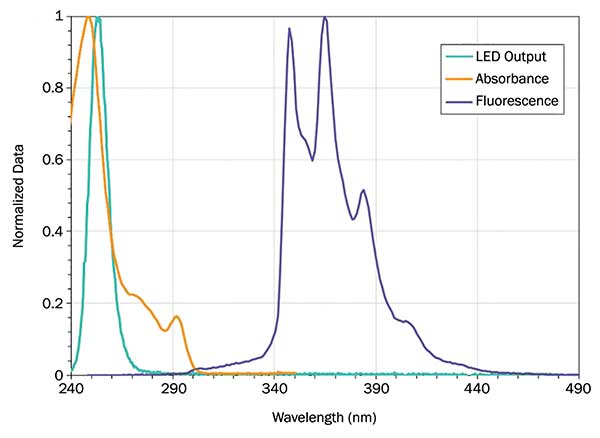
Figure 3. Absorbance and fluorescence spectrum of phenanthrene, with an overlay of the Crystal IS 255-nm Optan LED spectrum. Courtesy of Crystal IS Inc.
Fluorometers operating in the deep UV wavelengths typically employ xenon flash or deuterium lamps, which require more complex circuitry and typically have a higher cost of ownership than solid-state light sources like LEDs. As a result, CTG chose high light output, long lifetime lattice-matched UVC LEDs for its UviLux fluorometer.
In addition to PAHs, the UviLux fluorometer can also be configured to measure other wash water parameters, including colored dissolved organic matter, tryptophan-like fluorescence/biological oxygen demand and optical brightening agents (Figure 4).
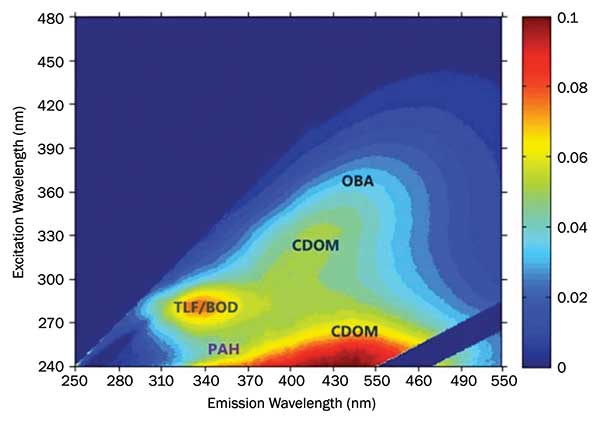
Figure 4. Fluorescence excitation-emission matrix of a natural freshwater sample, indicating polycyclic aromatic hydrocarbon (PAH); tryptophan-like fluorescence/biological oxygen demand (TLF/BOD); colored dissolved organic matter (CDOM); and optical brightening agents (OBA). Courtesy of Chelsea Technologies Group UK.
By combining absorbance and turbidity measurements, a correction is made for attenuation effects in the sample, which can be problematic in wash water with high color and/or turbidity. The company has demonstrated that with the system’s absorbance and turbidity correction algorithm, PAHs can be monitored over the required range of 0 to 4500 µg/L phenanthrene equivalence, in water turbidity up to 1000 formazin turbidity units (FNUs).
By addressing all four parameters, the system allows CTG customers, therefore, to meet the IMO’s environmental regulations by accurately monitoring wash water for PAHs (defined as phenanthrene fluorescence equivalence), as well as pH, turbidity and temperature.
Real-time process monitoring
UVC LED-based devices are also improving real-time process monitoring.
For example, due to the FDA’s Food Safety Modernization Act — which aims to ensure the U.S. food supply is safe by shifting the focus from responding to contamination to preventing it — the food and beverage industry is facing many challenges. These regulatory changes, combined with ongoing consumer pressures, require a fresh look at food safety, shelf-life management, product quality, process control and product traceability.
As a result, food and beverage companies are now employing compact, lower-cost spectroscopic sensors — mounted directly within their process flows — for real-time monitoring. The sensors are much more cost-effective, efficient and reliable than traditional methods, which include diverting the flow into special piping, or “grab sampling,” where samples are manually selected and brought to a lab for testing.
Which spectroscopic method is used — UV-VIS, Fourier transform infrared or Raman — depends on what’s being sampled. UV-VIS technology, for example, is ideal for quantitative and qualitative sample analyses in absorption, transmission and reflection measurement modes.
Until recently, deep UV or UVC (with a wavelength range of 200 to 280 nm) measurement devices employed deuterium or xenon flash lamps. While the lamps provide adequate light in the UVC wavelengths, they require costly filters and bulky power supplies. As an alternative, food industry sensor manufacturers now employ UVC LEDs to reduce sensor size and costs — while providing the same level of precision.
UVC LED-based technology is also helping the industry monitor the quality of process water — one of the most common ingredients in food. Ironically, while food and beverage producers require a certificate of analysis (COA) for other ingredients, they often overlook water quality. And that’s a major oversight because water characteristics can vary over time with regard to taste, odor, chemistry and the presence of microbes — all of which can alter the product’s taste.
Further, it’s not uncommon for process water to become contaminated with organics during manufacturing. And as food processing expands globally, water quality is becoming even more critical to product consistency. Water utilities in many countries have limited monitoring capability and/or employ unreliable analytical techniques.
To resolve these water-related issues, food and beverage companies employ total organic carbon (TOC) analyses — either by chemical methods or, spectroscopy at 255 nm — to maintain water quality throughout the manufacturing process. Chemical analyses based on persulfate oxidation are expensive, require more time between measurements, and have high consumable costs.
Until recently, UV systems using xenon flash lamps have been the preferred spectroscopy methodology. However, while these instruments offer precise, accurate measurements, the functionality exceeds what is needed at most food industry plants. The same analyses are now being performed using UVC LED devices, which employ a less costly detector and
consume less power. In fact, high-performance UVC LEDs offer linearity of measurement (Figure 5) that matches the performance of expensive xenon flash lamps, but at 40 to 80 percent of the cost.
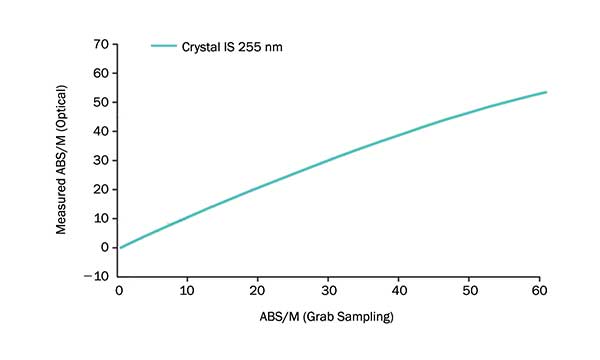
Figure 5. Total organic carbon (TOC) measurement (in absorbance/meter) using a Crystal IS UVC LED at 255 nm that shows the correlation between the optical methods of water-quality measurement with the reference chemical-grab sampling performed in the lab. Courtesy of Crystal IS Inc.
With the life expectancy and performance issues now resolved, instruments equipped with today’s UVC LEDs match and often exceed the performance of those equipped with UV lamps, while delivering higher efficiency and reduced costs for fixed wavelength applications. As a result, those in the LED industry see the fast-growing list of new applications as merely the tip of the iceberg.
Whether it’s a new, more precise system for monitoring product quality; a lower-cost lab device that lasts longer, takes up less room and improves overall productivity; or helping the shipping industry do its part to be more environmentally friendly, UVC LED technologies are expected to drive new and exciting innovations across an ever-increasing range of diverse, global applications.
Meet the author
Hari Venugopalan is director of product management at Crystal IS Inc., Green Island, N.Y. He has more than 10 years of experience in visible and UV LEDs; email: [email protected].